Top 10 Most Beautiful Cities To Visit In Portugal | Most Beautiful Cities In Portugal

- By
- Aparna Patel
- |
- 27 Apr, 2023
- |
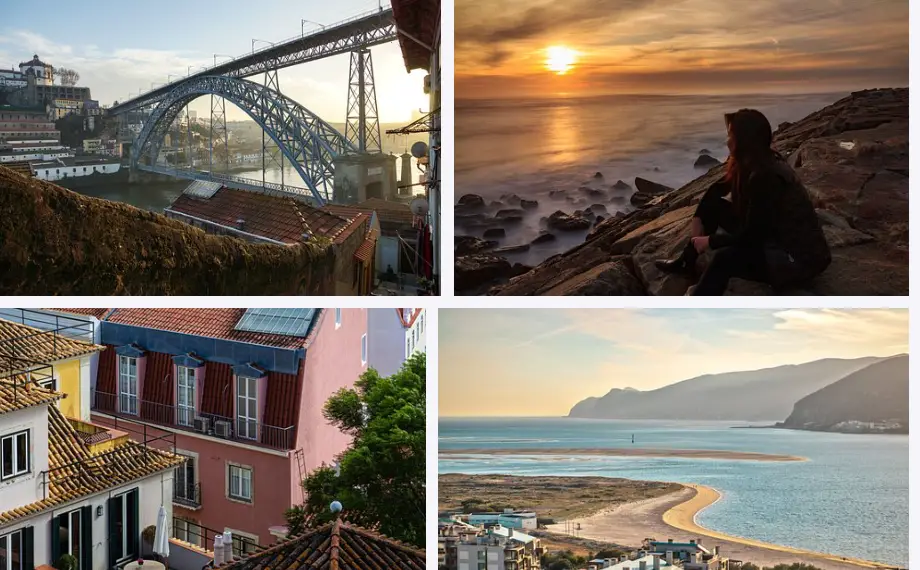
Welcome to our guide on the top 10 most beautiful cities to visit in Portugal. Portugal is a country with a rich history, stunning coastline, and breathtaking architecture that draws millions of tourists every year.
From the vibrant cities with lively culture to the small picturesque towns with narrow streets and colorful houses, Portugal has something to offer for every type of traveler.
In this article, we have compiled a list of the most beautiful cities in Portugal that you simply can’t miss. So, take a cup of coffee and get ready to explore the top 10 most beautiful cities in Portugal that will leave you mesmerized with their beauty and charm.
Best Cities To Visit In Portugal
Portugal is a beautiful country located in southwestern Europe, known for its stunning coastline, rich cultural heritage, and beautiful cities. Here are some of the most beautiful cities to visit in Portugal:
1.Lisbon
Lisbon is the capital city of Portugal, known for its stunning architecture, beautiful views of the Tagus River, and rich cultural heritage. Visitors can explore the iconic Belém Tower, visit the popular Jerónimos Monastery, and ride the famous Tram 28 through the city’s historic neighborhoods.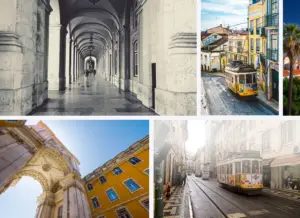
Lisbon is the capital and largest city of Portugal, located on the western coast of the Iberian Peninsula. With a population of over 500,000 people, Lisbon is known for its rich history, stunning architecture, delicious cuisine, and vibrant culture.
Here are some travel tips and information for visiting Lisbon:
- Getting there: Lisbon has an international airport, Portela Airport, which is located just outside of the city. It is served by many airlines, including TAP Portugal, Ryanair, and EasyJet. You can also take a train or bus from other cities in Portugal or from Spain.
- Getting around: Lisbon has an efficient public transportation system that includes buses, trams, and a metro system. The metro system is easy to use and covers most of the city. You can also take a taxi or ride-sharing service like Uber or Bolt.
- Accommodation: Lisbon has a range of accommodation options, from budget hostels to luxury hotels. Popular areas to stay include Baixa, Chiado, and Bairro Alto.
- Food and drink: Lisbon is famous for its seafood, so be sure to try dishes like grilled sardines, octopus salad, and codfish. You can also enjoy traditional Portuguese pastries like pastel de nata and queijadas. Lisbon has a thriving coffee culture and you can find great coffee shops throughout the city.
- Attractions: Lisbon has many attractions to explore, including historic sites like the Belem Tower and the Jeronimos Monastery, as well as cultural attractions like the Calouste Gulbenkian Museum and the National Museum of Contemporary Art. The city also has a lively nightlife scene, with bars and clubs in areas like Bairro Alto and Cais do Sodre.
- Safety: Lisbon is generally a safe city, but like any city, it’s important to take precautions. Be aware of pickpockets in crowded areas and keep an eye on your belongings. It’s also a good idea to avoid walking alone at night in less crowded areas.
- Language: Portuguese is the official language of Lisbon, but many locals speak English, especially in tourist areas. It’s always a good idea to learn a few basic phrases in Portuguese, like “hello” (olá) and “thank you” (obrigado/a).
- Climate: Lisbon has a Mediterranean climate with mild winters and hot summers. The best time to visit is in the spring (March to May) or fall (September to November) when the weather is pleasant and the crowds are smaller.
Overall, Lisbon is a beautiful and vibrant city with something for everyone. Whether you’re interested in history, culture, food, or nightlife, Lisbon has it all.
2.Porto
Porto is a beautiful city located in northern Portugal, known for its stunning architecture, beautiful Douro River views, and rich cultural heritage. Visitors can explore the iconic São Francisco Church, visit the popular Port wine cellars, and stroll through the beautiful Ribeira neighborhood.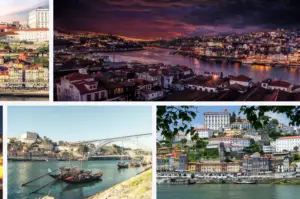
Porto is a coastal city located in the northwest region of Portugal. It is the second-largest city in the country, after Lisbon, and is known for its rich history, beautiful architecture, and world-renowned port wine.
Here are some travel information about Porto:
- Language: The official language of Porto is Portuguese, but many people speak English, especially in tourist areas.
- Climate: Porto has a mild climate with average temperatures ranging from 13°C (55°F) in winter to 25°C (77°F) in summer.
- Transportation: Porto has a good public transportation system, including buses, trams, and metro. Taxis are also widely available.
- Accommodation: Porto offers a range of accommodation options, from budget-friendly hostels to luxury hotels. Many tourists choose to stay in the historic Ribeira district, which offers stunning views of the Douro River.
Things to do: Porto is a vibrant city with many attractions and activities for tourists, including visiting the historic city center, exploring the Douro Valley wine region, and taking a boat tour of the river. The city is also known for its art museums, beautiful churches, and bustling nightlife. - Food and drink: Porto is famous for its delicious cuisine, which includes fresh seafood, hearty stews, and of course, port wine. Visitors can enjoy traditional Portuguese dishes at local restaurants or sample wine at one of the many wine cellars in the city.
- Safety: Porto is generally a safe city, but tourists should take common-sense precautions to avoid pickpocketing and other petty crime.
- Festivals and events: Porto hosts many festivals and events throughout the year, including the São João festival in June, which celebrates the city’s patron saint with fireworks, music, and street parties.
Overall, Porto is a wonderful destination for travelers who want to experience the best of Portugal’s culture, cuisine, and history.
3.Sintra
Sintra is a beautiful town located near Lisbon, known for its stunning palaces, beautiful gardens, and rich cultural heritage. Visitors can explore the iconic Pena Palace, visit the popular Quinta da Regaleira, and stroll through the beautiful Sintra National Palace gardens.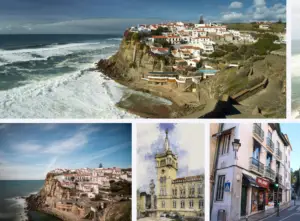
Sintra is a picturesque city located in the Lisbon Metropolitan Area of Portugal, approximately 25 kilometers northwest of Lisbon. It is a UNESCO World Heritage Site due to its cultural landscape, which includes historic palaces, mansions, and gardens.
Some of the must-see attractions in Sintra include:
- Pena Palace: A brightly colored Romanticist palace built on top of a hill, with stunning views of the surrounding area.
- Quinta da Regaleira: A Gothic mansion with an extensive park and garden, featuring mysterious underground tunnels, wells, and grottoes.
- Moorish Castle: A medieval castle built by the Moors in the 8th and 9th centuries, with panoramic views of the region.
- Sintra National Palace: A historic palace that served as a residence for Portuguese royalty from the 15th to the 19th century, featuring impressive Gothic and Manueline architecture.
- Monserrate Palace: A Romanticist palace surrounded by exotic gardens and featuring a mix of architectural styles, including Indian, Gothic, and Moorish.
To get to Sintra from Lisbon, you can take a train from Rossio Station or Oriente Station. The journey takes approximately 40 minutes, and there are frequent departures throughout the day.
The best time to visit Sintra is from March to June or from September to November.
Overall, Sintra is a beautiful and unique destination that is definitely worth a visit if you are traveling to Portugal.
4.Coimbra
Coimbra is a beautiful city located in central Portugal, known for its stunning architecture, beautiful river views, and rich cultural heritage. Visitors can explore the iconic University of Coimbra, visit the popular Biblioteca Joanina, and stroll through the beautiful Jardim Botânico.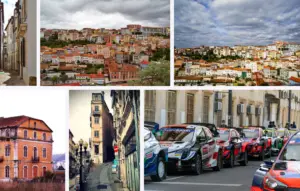
Coimbra is a historic city located in central Portugal, approximately 200 kilometers north of Lisbon. It is one of the oldest and most famous cities in the country, known for its prestigious university and rich cultural heritage.
Some of the top attractions in Coimbra include:
- University of Coimbra: One of the oldest universities in Europe, founded in 1290, and featuring impressive architectural landmarks such as the Joanina Library and the Royal Palace.
- Biblioteca Joanina: A stunning Baroque library built in the 18th century, with ornate decor and a vast collection of rare books and manuscripts.
- Coimbra Cathedral: A Romanesque cathedral dating back to the 12th century, featuring Gothic and Baroque elements and an impressive cloister.
- Portugal dos Pequenitos: A theme park and museum that showcases miniature replicas of Portuguese monuments and traditional houses.
- Monastery of Santa Clara-a-Velha: A medieval monastery founded in the 13th century, now partly submerged by the Mondego River and offering an interesting insight into Portugal’s religious history.
To get to Coimbra from Lisbon, you can take a train from Santa Apolónia Station or Oriente Station. The journey takes approximately two hours, and there are frequent departures throughout the day.
The best time to visit Coimbra is from April to June or from September to November when the weather is mild, and there are fewer tourists.
Read More
- Most Beautiful Cities To Visit In Croatia
- 10 Most Beautiful Cities To Visit In Turkey
- Most Beautiful Cities To Visit In Netherlands
- Most Beautiful Cities To Visit In Italy
Overall, Coimbra is a charming and historically rich destination that is worth visiting if you are traveling to Portugal.
5.Évora
Évora is a beautiful city located in southern Portugal, known for its stunning Roman ruins, beautiful Gothic architecture, and rich cultural heritage. Visitors can explore the iconic Temple of Diana, visit the popular Cathedral of Évora, and stroll through the beautiful Praça do Giraldo.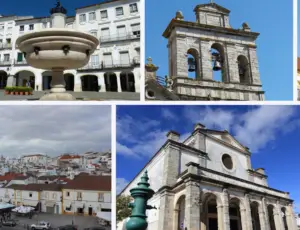
Évora is a historic city located in the Alentejo region of Portugal, approximately 130 kilometers east of Lisbon. It is a UNESCO World Heritage Site due to its well-preserved medieval architecture and cultural landmarks.
Some of the must-see attractions in Évora include:
- Temple of Diana: A Roman temple dating back to the 1st century AD, located in the heart of the city and offering beautiful views of the surrounding area.
- Cathedral of Évora: A Gothic cathedral built between the 13th and 14th centuries, featuring intricate carvings and stunning stained glass windows.
- Chapel of Bones: A macabre 16th-century chapel decorated with the bones of over 5,000 monks, offering a unique insight into the city’s religious history.
- Palace of the Dukes of Cadaval: A medieval palace that has been converted into a museum, featuring impressive works of art and historic artifacts.
- Almendres Cromlech: A prehistoric stone circle located outside of the city, believed to be one of the oldest megalithic structures in Europe.
To get to Évora from Lisbon, you can take a train or bus from the Sete Rios Station or a car from Lisbon’s airport. The journey takes approximately 1-2 hours, depending on the mode of transportation. Once in Évora, you can explore the city on foot, by taking a local bus, or by renting a bike.
The best time to visit Évora is from March to June or from September to November.
Overall, Évora is a fascinating and historically rich destination that offers a unique glimpse into Portugal’s cultural heritage.
6.Aveiro
Aveiro is a beautiful city located in central Portugal, known for its stunning Art Nouveau architecture, beautiful canals, and rich cultural heritage. Visitors can explore the iconic Aveiro Cathedral, visit the popular Museu de Aveiro, and take a traditional moliceiro boat ride through the canals.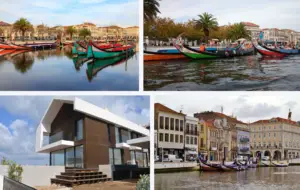
Aveiro is a charming city located in central Portugal, approximately 70 kilometers south of Porto. It is known as the “Venice of Portugal” due to its picturesque canals and colorful boats called moliceiros.
Places to Visit in Aveiro :
- Costa Nova: A beachside neighborhood known for its striped houses and beautiful sand dunes.
- Aveiro Cathedral: A Gothic cathedral built in the 15th century, featuring impressive stained glass windows and intricate carvings.
- Museu de Aveiro: A museum housed in a former convent that showcases the city’s art and cultural history.
- Mercado do Peixe: A seafood market that offers fresh fish and other local delicacies.
- Moliceiro Rides: A popular attraction that allows visitors to explore the canals of Aveiro aboard colorful boats.
To get to Aveiro from Porto, you can take a train from São Bento Station or Campanhã Station. The journey takes approximately 1 hour, and there are frequent departures throughout the day.
The best time to visit Aveiro is from May to September when the weather is warm and sunny.
Overall, Aveiro is a charming and unique destination that is definitely worth a visit if you are traveling to Portugal.
7.Braga
Braga is a beautiful city located in northern Portugal, known for its stunning Baroque architecture, beautiful parks, and rich cultural heritage. Visitors can explore the iconic Bom Jesus do Monte Sanctuary, visit the popular Braga Cathedral, and stroll through the beautiful Santa Bárbara Garden.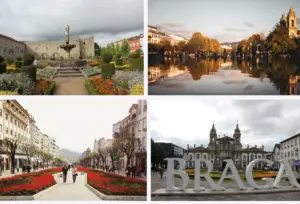
Braga is a historic city located in northern Portugal, approximately 55 kilometers north of Porto. It is known for its religious heritage, stunning architecture, and vibrant cultural scene.
Places to Visit in Braga :
- Bom Jesus do Monte: A Baroque sanctuary located on a hill overlooking the city, featuring a stunning staircase with fountains and chapels.
- Sé de Braga: A Romanesque cathedral built in the 12th century, featuring Gothic and Baroque elements and impressive artwork.
- Sameiro Sanctuary: A modernist basilica located on a hill opposite Bom Jesus, offering stunning views of the city and surrounding countryside.
- Braga Municipal Stadium: The home stadium of Sporting Clube de Braga, featuring a unique architecture inspired by the city’s religious heritage.
- Theatro Circo: A historic theater that hosts a variety of cultural events, including theater, music, and dance performances.
To get to Braga from Porto, you can take a train from São Bento Station or Campanhã Station. The journey takes approximately 1 hour, and there are frequent departures throughout the day.
The best time to visit Braga is from April to June or from September to November when the weather is mild, and there are fewer tourists.
More Post
Overall, Braga is a charming and culturally rich destination that offers a unique glimpse into Portugal’s history and religious heritage.
8.Viana do Castelo
Viana do Castelo is a beautiful city located in northern Portugal, known for its stunning Renaissance architecture, beautiful beaches, and rich cultural heritage. Visitors can explore the iconic Santa Luzia Sanctuary, visit the popular Gil Eannes Ship Museum, and stroll through the beautiful Praça da República.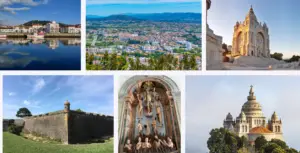
Viana do Castelo is a coastal city located in the northwestern part of Portugal, approximately 75 kilometers north of Porto. It is known for its picturesque old town, beautiful beaches, and traditional folk festivals.
Top attractions in Viana do Castelo:
- Praça da República: A charming square in the heart of the city, featuring traditional architecture and a beautiful fountain.
- Basílica de Santa Luzia: A Neo-Byzantine basilica located on a hill overlooking the city, offering stunning views of the surrounding area.
- Monte de Santa Luzia: A scenic park located on the same hill as the basilica, featuring gardens, walking trails, and panoramic views.
- Praia do Cabedelo: A popular beach located across the river from the city center, known for its long stretch of sand and excellent surfing conditions.
- Museu do Traje: A museum dedicated to traditional Portuguese costumes and textiles, showcasing the region’s rich cultural heritage.
To get to Viana do Castelo from Porto, you can take a train or bus from Campanhã Station. The journey takes approximately 1-2 hours, depending on the mode of transportation.
Best time to visit Viana do Castelo: The best time to visit Viana do Castelo is from May to September when the weather is warm and sunny.
Overall, Viana do Castelo is a charming and laid-back destination that offers a unique glimpse into Portugal’s coastal culture and history.
9.Guimarães
Guimarães is a beautiful city located in northern Portugal, known for its stunning medieval architecture, beautiful parks, and rich cultural heritage. Visitors can explore the iconic Guimarães Castle, visit the popular Alberto Sampaio Museum, and stroll through the beautiful Largo da Oliveira.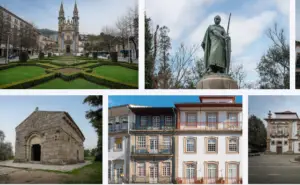
Guimarães is a historic city located in the northwestern part of Portugal, approximately 50 kilometers northeast of Porto. It is known as the birthplace of Portugal and is home to some of the country’s most significant cultural landmarks.
Top attractions in Guimarães include:
- Guimarães Castle: A medieval castle built in the 10th century, featuring a beautiful tower and a museum showcasing the city’s history.
- Palace of the Dukes of Braganza: A Renaissance palace built in the 15th century, featuring stunning architecture and beautiful gardens.
- São Miguel do Castelo Church: A Romanesque church built in the 13th century, featuring beautiful frescoes and a unique carved portal.
- Centro Cultural Vila Flor: A cultural center that hosts a variety of events, including theater, music, and dance performances.
- Largo da Oliveira: A charming square in the heart of the old town, featuring traditional architecture and a beautiful fountain.
To get to Guimarães from Porto, you can take a train from São Bento Station or Campanhã Station. The journey takes approximately 1 hour, and there are frequent departures throughout the day.
The best time to visit Guimarães is from May to September when the weather is warm and sunny.
Overall, Guimarães is a charming and historically rich destination that offers a unique glimpse into Portugal’s cultural heritage. It is a must-visit city for anyone interested in the country’s history and architecture.
10.Faro
Faro is a beautiful city located in southern Portugal, known for its stunning historic center, beautiful beaches, and rich cultural heritage. Visitors can explore the iconic Faro Cathedral, visit the popular Ria Formosa Natural Park, and stroll through the beautiful Largo da Sé.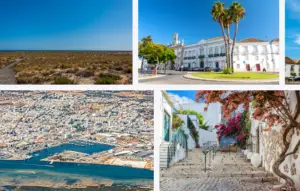
Faro is a vibrant city located in the southernmost region of Portugal, known as the Algarve. It is a popular tourist destination, thanks to its stunning beaches, rich history, and lively cultural scene.
Must visit places:
- Faro Old Town: A charming and historic area of the city, featuring traditional Portuguese architecture and a variety of shops, restaurants, and cafes.
- Sé Cathedral: A Gothic cathedral built in the 13th century, featuring stunning artwork and beautiful views of the city.
- Ria Formosa Natural Park: A natural park located just outside the city, featuring a variety of wildlife, walking trails, and beautiful lagoons.
- Faro Municipal Museum: A museum dedicated to the city’s history and culture, showcasing a variety of artifacts and exhibits.
- Praia de Faro: A popular beach located on a barrier island just off the coast of the city, featuring golden sand and clear blue water.
To get to Faro, you can fly directly into Faro Airport from various destinations in Europe, or take a train or bus from other parts of Portugal.
The best time to visit Faro is from May to September. If you prefer a quieter experience, consider visiting in the shoulder seasons of April or October.
Overall, Faro is a lively and culturally rich destination that offers something for everyone. Whether you’re interested in history, nature, or just relaxing on the beach, this charming city is a must-visit destination in Portugal’s Algarve region.
Related Articles
- Most Beautiful Cities To Visit In Norway
- 10 Most Beautiful Cities To Visit In Greece
- 10 Most Beautiful Cities To Visit In Sweden
Getting around: Portugal has a well-developed public transportation system, including buses, trains, and trams. Visitors can also rent a car to explore the country at their own pace.
Accommodation: Portugal has a wide range of accommodation options, from budget-friendly hostels to luxurious hotels.
Search Posts
Latest posts
-
4 Mar, 2024
Why would you wrap your luggage in plastic?
-
5 Mar, 2024
Why prohibit engine braking?
Popular posts
-
5 Mar, 2024
Why prohibit engine braking?
-
5 Mar, 2024
How to avoid drinking vodka?